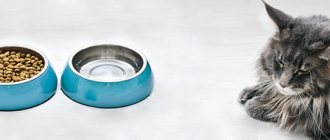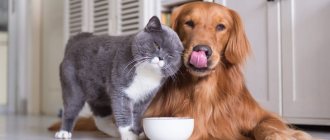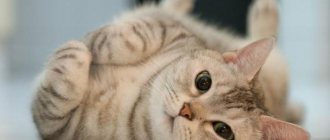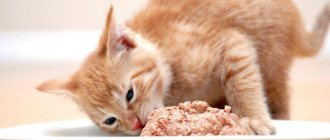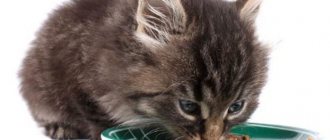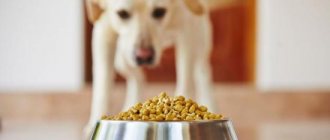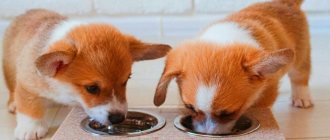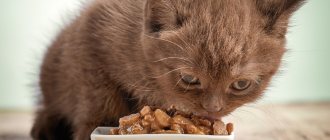Cats are carnivores; their bodies require food of animal origin. For the full development and normal well-being of a domestic cat, so that it is in good physical shape and has a beautiful coat, it requires a diet that balances organic (proteins, fats, carbohydrates) and inorganic (microelements, vitamins) substances.
Feeding the cat with leftovers from the owner's table is the worst option. Not everyone can organize natural nutrition, that is, prepare food specifically for a pet every day. Therefore, many people choose ready-made food, trying to ensure that it can consistently provide the pet’s body with the necessary substances. There are two types of cat food - dry and wet. Each of them has its own advantages and disadvantages.
The importance of proper diet
One of the most popular pets is cats. They actually spend almost all their time at home, not going outside very often. And perhaps never.
Despite this universal popularity, many cat owners do not know exactly how many times a day they need to be fed. The question arises both among those people who have already got a furry pet, and among those who are planning to purchase one. Many will decide that it makes no difference how often, what and when to feed a cat. However, her mood, health and life expectancy depend on proper feeding and diet.
A correctly composed menu and the number of feedings per day affect the condition of the gastrointestinal tract of the pet and its entire body as a whole. The owner must carefully study the issue of nutrition to maintain the correct balance of proteins, fats, carbohydrates, minerals and vitamins.
Proper nutrition is the key to a healthy cat
Making a diet for a kitten
Every cat lover will be very happy and immensely happy when a little furry friend - a kitten - appears in his home. This cute ball of fur will make anyone smile even on the stormiest day, will always give its owner a piece of his enthusiasm and infect him with positivity.
A small pet already has its own character and habits, but it still requires attention and education. And in order for a tiny organism to grow and develop properly, it is necessary to take care of the optimal diet for it.
How to make a cat's diet
A cat's diet is primarily influenced by the age and health of the cat. But nutrition also depends on the type of diet that the owner prepares for her. There are three most common options:
– regular food from the table;
– natural food;
– dry or wet store food.
You should not feed your cat from the table, because many “human” foods are very harmful to the animal. The cat's body suffers from many foods that humans usually consume: salty, fried, sweet.
Food from the common table is harmful for cats
Natural foods, especially when properly prepared, provide a good balance of essential nutrients. However, preparing such food takes much longer and can be significantly more expensive than other options. The cat's diet should include meat products (beef/veal or minced beef, chicken meat, chicken by-products, lamb, turkey), eggs and liver, porridge (rice and buckwheat), fermented milk products, bran bread, vegetables (for example, cauliflower). cabbage and beets). Every day, a little of everything or alternating days.
Natural food is most beneficial if it is varied
Industrially produced food, as a rule, contains all the vitamins and microelements necessary for the animal to saturate the body. But you should pay attention to the composition, because... Cheap food often uses dyes and flavor enhancers that are harmful to cats. Observe the shelf life. Dry diets are edible for 12 to 18 months. They do not need to be put in the refrigerator, but at the same time they are afraid of direct sunlight, heating devices and high humidity. Bags of dry food should be kept sealed to prevent them from losing their odor. Wet food is sealed and sterilized, so it lasts longer—up to two years—and doesn't need to be refrigerated. The cat is by nature a predator and does not eat carrion, so it prefers food at room temperature.
Store-bought food is perfectly balanced and saves the owner time
Calorie content
According to the established norm, one kilogram of an adult cat’s weight per day should not exceed 70 kcal. The easiest way to monitor caloric intake is when your pet receives commercial food. You can easily find all the necessary information on the packaging. It will be a little more difficult with a natural menu, because then the owner has to count calories on his own.
Counting calories - controlling your pet's weight
Daily weight
The weight of food that a cat should eat per day depends on exactly how much the animal weighs. For every kilogram of body weight there should be from thirty to sixty grams of feed. With a high caloric content of food, thirty grams per kilogram of weight is enough. If the nutritional value is low, the weight of the feed can be increased to sixty grams per kilogram of animal body weight.
Water mode
Water is one of the key nutrients. Especially for cats that eat dry food. Lack of fluid can lead to serious problems. Dry food in a humid environment gets wet and swells, filling the stomach, therefore, the cat needs less food. Of course, absolutely all cats need water, regardless of the type of diet. To do this, be sure to have a container of water next to the bowl of food.
Water is important and necessary for a cat
It is necessary to replace the water every day, as cats love to drink fresh. It is better to give soft water with a low mineral content, which is very important for a cat, given its tendency to urolithiasis. The animal drinks about 9-10 times a day, but little by little.
When choosing a drinker, pay attention to the material from which it is made. It is very likely that your cat will not drink from a plastic saucer because this material absorbs and retains unpleasant odors. It is better to buy a glass, ceramic or porcelain bowl with the same bottom and surface area with a volume of approximately 200 ml.
Industrial feed: pros and cons
Industrial animal feeds are divided into two types:
- wet food - canned food in the form of pates, pieces of meat with sauce;
- dry granulated food - small crackers.
Feeding natural food will require a lot of knowledge, patience and time. With skillful preparation of a correct and balanced menu, such nutrition will be healthier and safer.
Ready-made food has its advantages and disadvantages compared to natural food.
Industrial feed is better for several reasons:
- contains a complete balance of essential vitamins and microelements;
- easy to calculate and control the size and number of servings;
- long shelf life;
- feeding with dry food is more convenient;
- the opportunity to choose specialized veterinary food that meets the needs of a cat with health conditions.
Cats that eat only dry food must always have fresh water available.
Disadvantages of using industrial feed:
- high cost of quality feed;
- In canned food with sauce, more than half of the volume is water. Satiety with such food is reduced;
- high salt content, which threatens the development of urolithiasis;
- This food is addictive. It becomes very difficult to switch a cat to a different diet.
When feeding with ready-made store-bought food, you should pay attention to the mark indicating whether any type of food is complete. It can only serve as an additive to the main diet and does not satisfy all the nutritional needs of the cat.
When combining dry food with canned food, it is better to stick to the proportion - about 70% dry food and 30% canned food.
Some artificially bred cat breeds are susceptible to allergies and metabolic disorders. To maintain health, it is recommended to feed them only with fully balanced ready-made special food.
Factors influencing diet
A cat's diet can change depending on the physiological changes that occur in its body. The serving size should always be the same and appropriate to the needs of the cat depending on its weight, age, breed, activity.
Healthy cats don't overeat
Particular attention should be paid to kittens, pregnant women, older pets, sterilized cats and neutered cats. For them, adjustments in diet and its balance are required.
The main factors influencing the diet include the health of the cat. Diabetic animals, stressed pets, and cats suffering from vitamin deficiency may be constantly hungry. It is important to promptly respond to any warning symptoms that may be associated with a feeling of hunger (thirst, anxiety, poor condition of hair and skin, upset stool, etc.). If any appear, you should immediately contact a veterinarian.
Sometimes animals beg for food or approach the food bowl literally out of idleness. It is important to be able to distract the animal from food, for example, through joint games with the owner. A cat should have a variety of toys with which it can brighten up its leisure time.
Cat diet in numbers
Feeding standards for cats depend on many factors:
- age;
- gender;
- size and weight;
- breeds;
- health conditions;
- lifestyle;
- type of food - dry, canned, natural products;
The question may arise: does the number of feedings depend on calorie content? Depends directly. This is one of the most important factors that determine the size of portions and their quantity throughout the day.
A cat will need more food if its food is low in nutritional value. It is better to choose a diet that, without compromising health, will satisfy the needs of twice feeding, morning and evening. It is better to choose a higher nutritional value over the amount of feed.
The optimal calorie content of the daily diet should be about 70 kcal per 1 kg of weight. Depending on the calorie content, the weight in grams of the daily norm is determined at the rate of 30-60 g per kg of the cat’s weight and is about 250 g.
Thus, an adult, healthy cat weighing 5 kg can eat 250 g of food per day with a total calorie content of 350 kcal.
Cats have a high need for amino acids. The meat and protein component in their diet is preferable to vegetables or cereals. Carbohydrates in the daily amount of feed should be no more than 3%, fats - no more than 15%.
How many times a day should an adult cat be fed?
So how often per day should you feed your cat? If you have an adult and healthy individual, then the simplest answer is two times. It is better to divide your meals into two – morning and evening.
A cat may beg for food even when it's not hungry.
You should not feed your cat on demand. This can lead to serious problems: excess weight gain, heart problems, breathing problems, constipation and other unpleasant consequences.
Diet for a cat is just as important as for a person. Constant feeding from the table (a piece of cheese or sausage) is harmful to the health of the animal. Also, such actions will only spoil your pets.
How much food to give a cat per day with a mixed diet?
Some owners practice mixed feeding with granules and wet food. It is known that a spider weighing 100 g approximately corresponds to 22 g of dry food. If a cat is offered one pouch per day, then the amount of dry food is given in accordance with the table.
| Weight kg, fatness | 2,5 | 3,5 | 4,5 | 5,5 | 6,5 |
| Normal | 17 | 29 | 39 | 49 | 58 |
| Excessive | 9 | 18 | 26 | 34 | 41 |
For large pets, you can use a scheme with two spiders. In this case, the cat needs the following amount of granules:
Be sure to read:
When to start feeding kittens: how to introduce them, diet, what not to feed, age for first feeding
| Weight kg, fatness | 5,5 | 6,5 |
| Normal | 27 | 36 |
| Excessive | 12 | 29 |
How many times a day should you feed a kitten?
Kittens need a different schedule compared to adults and require more frequent meals. If for some reason the kitten is not fed by the mother cat, then the newborn should be given cat milk replacer from a pipette every 2 hours (without a break at night). Then kittens up to 2 months are fed every 6 hours, gradually introducing crushed adult food into the diet (meat, cereals, vegetables, dairy products). Closer to 4-5 months, the baby can be switched to three meals a day (morning, afternoon and evening). And after 6-8 months, the kitten can be fed twice a day, although some owners choose three meals a day for pets up to a year.
Kittens need special care
Norms for kittens by month of life
The decision on how many times a day to feed a kitten depends on the baby's age in months. During growth and development, the cat's body requires more feedings throughout the day.
From birth and during the first month
If a newborn kitten is separated from its mother for any reason, then the responsibility of feeding the kitten falls on the shoulders of the person. If you couldn’t find another cat that could feed you with its own milk, you should feed the kitten without a mother a special formula. You can use infant formula for newborns.
It is forbidden to give a newborn kitten whole cow's milk in the first month of life; this is a very heavy food.
To develop the sucking reflex, it is advisable to use a bottle when feeding. You can try feeding from a pipette.
During the first three days you need to feed every two hours, including at night. Then, by the 10th day of life, the interval between feedings is increased to 4 hours. For the first two weeks, the daily intake of formula for a kitten is 30-40 ml per 100 g of baby’s weight.
A one-month-old kitten should be fed exclusively with formula, increasing its volume to 50-55 ml per 100 g of weight by day 30. Then start feeding him adult food.
1-2 months
The age of a kitten from a month to two months is the time to accustom it to food in pieces. By the end of the second month, the kitten should eat about 200 g of food, which is divided into 5 feedings. You can offer him oatmeal or rice milk porridge with the addition of a chicken egg. If ready-made food does not cause digestive upset, then you can completely switch the kitten to natural feeding.
2-3 months
A 2 month old kitten needs to be fed 4 times a day. He can already eat about 300 g of food, cut into small pieces. For example, you can offer minced meat.
3-4 months
A 3 month old kitten needs to be fed 3 times a day. The total volume of food eaten is approximately 360 g. Until this age, pieces of dry food must be soaked in water when feeding. At 3 months, kittens change their teeth and can already be introduced to solid food.
4 months and older
By this time, the kitten’s menu should consist of 75% meat protein foods.
Under no circumstances should you feed your kitten raw or fresh meat. This threatens protein intoxication or infection with parasites.
By six months, you can gradually transfer the grown kitten to two meals a day.
How many times a day should a spayed or neutered male cat be fed?
After castration and sterilization, male cats “appetite awakens.” They can constantly beg for food and also gain weight very quickly, which leads to obesity. But you need to feed a sterilized cat or neutered cat twice a day, no more often, like other adult animals that have not undergone surgery to remove their reproductive organs. A good option would be to use special food designed specifically for such animals.
Spayed and neutered cats tend to gain weight
Reviews about natural feeding
Ekaterina: At first, my kitten had a huge belly, ribs were sticking out, we brought it into the form that we considered necessary. He was weak, thin (his ribs and even his spine were sticking out), with a huge belly (there was a feeling that it would burst), he slept all the time, had almost no voice (he gave out something uterine), and also fell ill with a runny nose and conjunctivitis immediately after the move . For a whole month I couldn’t remember my name, I was completely lost in myself. This is despite the fact that the cat came from a nursery, with documents, and was even sold for breeding. Within 2 weeks after switching to meat, the kitten’s stool returned to normal and the stomach began to subside. In the first month, he gained another weight: at 3 months he weighed 1 kg, at 4 months - almost 2 kg. By 5 months the stomach had finally returned to normal. At 10 months, the cat weighs 4 kg, normal build, beautiful silky coat. There are no health problems.
Olga: By the age of five, my Fili had plaque on his teeth, although he ate dry food and I was told that dry food cleans his teeth. But that's not true. Some time after switching to natural products, the plaque disappeared, because... it cleaned itself naturally using bones. Of course, if the cat had a stone, then the bones would no longer help, but they coped with the plaque.
Alexander: I think it’s wrong to feed your pet pads that were made at the factory and nobody knows what they put there. Well, I don’t trust manufacturers, because they only want to reduce the cost of production at the expense of quality. I have a cat and a cat - both eat meat. There are no health problems.
Lisa: I have a Scottish cat on a natural diet. Before the age of four, we earned a bunch of different diagnoses while being dry. In particular, the cat went to the toilet with a lot of blood. When we switched to natural, the problem went away.
Galina: At first it was difficult to figure out all these proportions, grind the meat, and so on. But then the proportions somehow settled into my head, and they stopped cutting the meat so finely, because cats learned to eat large pieces. As a result, in about six months, the amount of work on preparing a natural diet for a week (we buy for a week) seemed to have decreased by half. It's only difficult at first.
Animal weight measurements
It is necessary to constantly weigh cats, especially kittens, to understand the correctness and completeness of their diet. Females often weigh less than males, and the weight of the animal depends very much on the breed. For example, in a year the British weigh from 4.5 to 7 kg, Maine Coons at the same age gain weight from 5.9 to 9 kg.
It is important to control your cat's weight from birth
However, the standard weight for most breeds of domestic cats is from 2.5 to 4.5 kilograms. If your cat's indicators go beyond these limits, you need to look for a different approach to feeding her. You may need to change food, increase or decrease the number of meals, and so on. Every animal, like every person, is unique. Therefore, the diet for him must be selected individually.
Feeding standards for wet food
Some breeders and veterinarians recommend following the following proportions when feeding a cat with industrial food: feed 2/3 of dry food to 1/3 of wet food. Feed should be purchased from one manufacturer.
Wet food is usually produced in canned form or in small bags (packs)
Do not forget that you cannot mix industrial food and natural food, as it is difficult for a cat’s stomach to adjust to new food.
If an adult cat has been eating natural food since childhood, it will take him at least two weeks to accustom his body to store-bought food.
Table
There are many options for distributing cat food depending on the age and weight of the cat. After all, there is a difference in how to feed a one-month-old kitten and, for example, an adult 7-year-old cat. Here is an approximate table for feeding a furry pet:
| Cat weight | Feeding rates depending on the type of food | ||
| Healthy eating | Nutrition for weight loss | For an older animal | |
| 2 kg | 40 g | — | 30 g |
| 3 kg | 45 g | — | 30 g |
| 4 kg | 60 g | — | 40 g |
| 5 kg | 75 g | 60 g | 60 g |
| 6 kg | 80 g | 60 g | 60 g |
| 8 kg | 105 g | 75 g | 90 g |
| 10 kg | 120 g | 80 g | 105 g |
But do not forget that these are generalized figures; only a competent veterinarian will select an individual healthy diet after carefully examining the animal.
How to tell if your cat has enough food
There are norms for the daily amount of food for cats of different ages, recommended by experts. But they are not always suitable for each specific animal. For example, you can determine whether your cat is getting enough food by observing her for some time. If she is malnourished, looking for food, there is weight loss, the coat is dull and falling out, then in this case the amount of food needs to be increased slightly. As a rule, healthy animals do not overeat. But sterilized cats or neutered cats, as we have already mentioned, may be prone to gluttony.
Follow your daily food intake limits
If there is no constant opportunity to weigh your pet, then you can simply feel its body. When the ribs cannot be felt, most often the weight already exceeds the norm.
General rules
Feeding cats with natural food should be done in a calm environment, at approximately the same time, so that there is a certain regime.
Food is at room temperature—neither cold nor hot. Hot will burn, and cold makes digestion of food much more difficult, to the point that the food will not be digested at all. This is especially dangerous when feeding bones.
The plate is taken away immediately after eating and washed without chemicals - only plain water. You don't need to leave your cat's plate out all day if she doesn't eat it all at once. Since she ate so much, it means she needs so much. Do not provoke him to eat during the day. Moreover, natural products quickly deteriorate.
The food is presented either in small pieces or in large pieces if the cat is able to handle them. But broths, soups and minced meats are permanently prohibited for cats.
Naturally fed cats drink less water because... meat consists of 60-80% of it, that is, water enters the body along with food. In the process of evolution, mammals have learned to extract moisture from food. By the way, people often confuse appetite and thirst for this very reason: the body requires water, which can be obtained from food.
Should you leave food in a bowl?
Whether or not to leave food in a cat’s bowl for the whole day is up to each owner to decide individually. However, if possible, you should remove food from the bowl if it has been there for more than twenty minutes. If the pet has not eaten it within a given period of time, then it is not very hungry. If a cat, after rapidly becoming full, suddenly begins to lazily nibble on its food, this is the first sign that it is full. She continues to chew only because she has access to food.
It is advisable to remove uneaten cat food from the bowl.
If you go on vacation or a business trip and have to leave your cat alone at home for a long time, you can purchase an automatic feeder and charge it with dry food pellets. They can be stored in a feeder for up to two weeks without loss of taste and nutritional qualities. But this option is best left for the most desperate situations.
Removing uneaten food is especially important if the cat eats natural food. The possibility of poisoning from a spoiled product cannot be allowed.
Bowls
Since we are talking about bowls, it is worth paying attention to the fact that the dishes from which the animal eats should not have high edges. The reason is extremely simple - everyone knows that cats’ whiskers serve as a sensor. It determines whether she can get through any hole or not. And if the bowl of food is narrow or has high edges, then the cat will constantly trigger this sensor, telling her that it is better not to touch such a container.
Naturally, the animal decides for itself whether it should try to penetrate this or that hole or not. Therefore, the cat will not remain hungry. But this little thing will cause her serious discomfort. Therefore, it is best to give food to the animal in a flat, wide plate. Please note that dishes for people and animals should be different. If it looks similar, store it in different places and wash it separately.
Useful tips
Among other things, you can give some more useful tips on feeding cats:
- If there are several pets in the house that require different diets, feed them separately from each other.
- Be sure to combine wet food with dry food - when chewed, it cleans the teeth of plaque.
- If in the summer heat your cat refuses to eat, but in the fall, on the contrary, eats with excessive appetite, this is normal. Don’t be alarmed, this is how the animal reacts to the changing seasons.
- Cat food should be stored like human food, i.e. observing all sanitary measures.
- Sometimes you can't be too strict. Observe which food your pet enjoys the most, and don’t be shy about pampering him.
- And one more prudent advice: do not start feeding the kitten from your table. To keep those big green eyes by your side for more than twenty years (this is a very realistic period for a pet), do not give him treats from your plate.
How to choose your cat's food type
Every person who has connected his life with animals must realize that mistakes cost the health of the person under his care. When unfortunate breeders bring a kitten into their home, they do not realize that a cat that eats “from the table” will sooner or later begin to get sick. However, even responsible and conscientious owners are faced with a choice of what to feed their pet - “natural” food, dry food or canned food. Let's look at the main pros and cons of each type of food.
Some rules for using dry food
When switching a cat to standard dry food, a number of rules should be followed:
- Do not alternate natural products and professional food. With a mixed diet, the load on the animal's liver increases, and the animal's stomach cannot quickly adjust from one type of food to another.
- Purchase premium and super-premium food, such as Purina ONE® dry cat food or other well-established brands.
- Do not use additional vitamins or other additives; high-quality feed initially contains all the necessary vitamins, minerals and trace elements.
- Provide sufficient clean water. The volume of water consumed should be three times the volume of dry food eaten.
- Purchase food taking into account the characteristics of the cat’s body. Leading manufacturers produce food for kittens, teenage cats, pregnant, spayed or neutered, and elderly or debilitated animals. Medicinal types of food are also produced.
At first glance, the recommended portion of dry food seems excessively small, especially in comparison with the daily amount of wet food or natural food eaten, but it is not recommended to increase it.
Feeding with prepared food
Today there is a huge variety of ready-made food for cats and many owners choose this type of food. This is convenient, because not everyone has the time to prepare natural dishes from healthy ingredients. The composition of ready-made feeds - dry or wet, is well balanced. Such products give the animal everything it needs. Of course, if it is food belonging to the premium or super-premium category. Food in the so-called budget category is not recommended by experts.
Feeding frequency
Proper nutrition is not only a balanced diet, but also a sufficient frequency of feeding. Its mood and health depend on how many times a day a pet receives food. Feeding at strictly designated times prevents obesity and helps normalize digestion, and also makes it possible to assess your pet’s appetite and control the amount of food consumed. In addition, supplying feed at a certain time prevents food spoilage during the hot period.
The frequency of feeding pets at the age of 2-3 months is 4-5 times, at 4-5 months - 3-4 times, after six months - 3 times, and for an adult it is enough to eat 2 times.
Should you leave food in a bowl?
It happens that the owner does not have the opportunity to give food to the pet at a certain time. In this case, experts recommend leaving the daily amount of food in a bowl. The animal, having free access to food, can eat when the need arises. In this case, you should know how much food - granules or canned food - a cat needs per day.
It is not recommended to leave food in a bowl for a small or pet prone to overeating.
Daily feed intake
Ready-made cat foods sold by one brand or another have different nutritional values. Typically, the food packaging indicates the age and weight of the animal, as well as the recommended amount of product. Dry food is croquettes consisting of a mixture of meat, cereals and plant products, dried in a special way. Such products are very convenient - they can be safely left in a bowl when the pet is left alone for a long time.
Dry food contains very little moisture - no more than 10%. Therefore, if dry food predominates in your pet’s diet, you need to make sure that there is always a sufficient amount of water in his bowl.
It is impossible to visually determine what the dry product granules consist of. Therefore, when choosing a brand of food, you should give preference to premium and super-premium products. These include: Royal Canin, ProPlan, Iams, Nutro Choice, Acana, 1st Choice.
It is impossible to visually determine what the finished food consists of, so you need to choose products from trusted manufacturers who sell premium and super-premium products
Most manufacturers produce ready-made food for certain age categories - for kittens from 3 months to a year, for adults from one to five years, for animals from 5 years. Some brands offer products for certain breeds of animals. Special food for neutered pets is also sold.
Wet food is available in the form of canned food and pouch bags. The latter are sold in volumes of 85–100 grams. This product consists of pieces of meat, vegetable products or grains drenched in sauce. The moisture content of this food is 20%. Canned food is produced in the form of pates or stews. In addition to meat, fish and vegetables, they contain useful vitamin supplements. Canned food is practically in no way inferior to nutritious, high-quality food.
In a diet consisting of prepared foods, the share of wet food should not exceed 25%. Both granules and canned food must be of the same brand.
Typically, all manufacturers of quality feeds include information on the recommended daily intake of the product on the packaging. It depends on the age of the pet and its weight. The lower the recommended dose, the more nutritious the product. The wet product rate is 5% of the animal’s weight. The approximate daily amount of dry finished product for adults is:
- if the weight does not exceed 3 kg - 25 grams;
- with a weight of 3 to 4 kg - 40 grams;
- with a weight of 4 to 5 kg - 55–65 grams;
- with a weight of 5 kg - at the rate of 12 grams per kilogram of weight.
For kittens weighing up to 2 kg of food per day, 35 grams are needed, and individuals weighing from 2 to 3 kg need 50 grams. For pregnant and lactating females, the amount of food should be increased by approximately 2 times. So, a cat bearing offspring, weighing from 4 to 5 kg, needs 100–130 grams per day.
Some manufacturers, in particular Royal Canin, produce food for certain breeds, such as Siamese, Persian, British and others
You need to gradually switch your pet to another type of food. Over the course of about a week, you need to mix the new product with the old one, gradually increasing the volume of the new one.
Can adults eat ready-made kitten food? Food for babies contains more carbohydrates, which they need for active growth and energy. An adult animal does not need such an amount of carbohydrates. It is better to buy ready-made food corresponding to the age of the animal.
Water in a cat's diet
Clean water should be in your pet's bowl at all times. With a natural type of feeding, the animal needs less liquid. If your pet's diet consists of ready-made dry foods, then it will consume more water. How can you tell if your cat has enough water? If her fur is shiny and silky, she is active and urinates at least 2 times a day, then there is enough fluid in her diet.
Is ready-made pet food harmful?
Only a product belonging to the economy category can be considered harmful ready-made food for cats. Manufacturers of such prepared food use meat waste - intestines, skin, heads and low-quality offal. In addition, such foods contain a lot of rice, corn flour and various additives of little use. Eating such foods leads to disruption of many body systems and hair loss.
Finished premium and super premium category products are prepared from high-quality meat and vegetable products and cereals. They contain everything a pet needs for normal functioning. To avoid the development of urolithiasis when feeding dry foods, you should ensure that your pet drinks enough water.
Owners who are planning to wean their pet off ready-made food have to face certain difficulties. Most manufacturers of economy category products add a variety of flavors and flavor enhancers to feed. The animal gets used to this “chemistry” and does not want to eat anything else.
Your pet should be weaned off low-quality dry food gradually. There are two ways:
- You should give your pet ready-made food in the first half of the day, and natural food in the second. If an animal does not want to eat unusual food and is loudly “indignant,” you should not succumb to its provocations. If the cat has not touched natural food, it should be removed after 20–30 minutes.
- Natural food should be mixed with the finished product, gradually increasing the proportion of regular food. The granules of the finished product should be pre-soaked in water, then the liquid should be drained and mixed with natural food in a ratio of 5 to 1 (5 parts dry food and 1 part regular food). After a week, the share of natural food can be increased and so on until the animal is completely weaned off canned food.
The animal has a very strong instinct of self-preservation. Not a single cat will die of hunger just because it is not given the usual food. A couple of weeks of “indignant screams” and the pet will get used to regular food.
Natural diet
Drawing up a complete diet with a natural type of nutrition requires compliance with certain rules and patience. Representatives of the cat family are known to be conservative and therefore do not require variety in food. Once properly prepared, the diet can be used by the owner constantly.
Usually a pet goes to a new home at the age of 2-3 months. During this period, the frequency of feeding the animal is 4–5 times a day, and a sufficient amount of food is 180–200 grams. For large kittens, for example, the Maine Coon breed, the daily amount of food should be approximately 230 grams.
During the period of intensive development, the proportion of protein in the pet’s diet should be from 60 to 80%. The calorie content of the daily diet of a three-month-old kitten is 200 kcal.
At 4–5 months, the frequency of food intake by animals can be reduced to 3–4 times. A pet should receive up to 240 grams of food from natural products per day. After 6 months and up to a year, a three-time meal plan is suitable for a cat. After a year, the pet becomes an adult and should eat no more than twice a day. Of the 200–250 grams of daily food volume, protein foods should account for 100–150 grams. An adult animal does not need as much energy as a furry baby, so its caloric intake should be 80 kcal. The exception is females bearing offspring and lactating - they should receive approximately 2 times more energy from food.
To maintain your pet's health, it is very important that he always has access to water. It needs to be changed 2 times a day.
Table: allowed and prohibited foods in cat food
| Authorized products | Prohibited Products |
| Lean meat (rabbit, turkey, beef, chicken) – boiled or frozen. | Fat meat |
| Sea fish (boiled only). | Cow's milk |
| Low fat fermented milk products. | Bread, pasta, sweets (any) |
| Boiled yolk. | Salt, spices |
| Offal. | Onion garlic |
| Herbal products (except prohibited ones) | River fish |
| Porridge | Potato |
| Oils - olive, flax, sea buckthorn. | Mushrooms, legumes |
| Canned food, smoked meats |
Vegetables, such as carrots, pumpkin or zucchini, can be given raw or boiled. It is better to give plant food in tandem with meat or cereals - this way the animal will be more willing to eat it.
The animal should be accustomed to vegetables from childhood, and in order for the cat to be more willing to consume plant products, you need to mix them with meat
Contrary to popular belief that cats are big fans of milk, giving this product to a kitten after three months is not recommended. As felines age, they develop lactose intolerance and if they consume milk, cats may have digestive problems.
An owner who feeds his pet natural products must take care to enrich the food with vitamins. Vitamins A, C, E, categories B and D, as well as calcium, iron, taurine, potassium, phosphorus, magnesium bring particular benefits to the animal’s body. A veterinarian will help you choose the right drug. The most popular vitamin complexes include Beaphar Kitty's Mix, Polidex Immunity up, Doctor Zoo, Radostin.
Gimpet malt paste will remove lumps of fur from your pet’s stomach that get inside after the cat licks its fur. A special herb can also help with this problem. The mixture for its germination is sold in pet pharmacies and stores.
Example of an optimal menu
To save time, you can prepare balanced nutritional formulas in advance and then freeze them. The following recipes, recommended by experts, fully satisfy the cat's needs:
- A mixture of beef, rice or buckwheat and vegetables. Meat - 2 kg, cereal - 200 grams, vegetables (any allowed) - 500 grams should be boiled separately. Then the products should be minced and divided into portions and frozen. For a pet weighing 3–5 kg, this amount of food is enough for 7 days.
- A mixture of 1 kg chicken fillet, 100 grams of boiled rice and 150 grams of vegetables. Scroll through all the ingredients, form them into meatballs and boil. Next, balls of meat, cereals and vegetables should be cooled and frozen.
In addition to meat, plant products and cereals, the animal's diet should include at least 30 grams (daily dose) of fermented milk products.
Recently a new pet appeared in our house - a mixed-breed kitten. His mother is a purebred “British”, and his father is a mongrel cat. We chose to feed the animal with regular products. His diet consists of boiled chicken, well-boiled buckwheat with vegetables - carrots or zucchini, and 1% fat kefir. There is always water in the second bowl. All types of food Bagel - that’s the kitten’s name; he eats willingly, of course, meat with great pleasure. His fur is thick and shiny, the kitten is active - sometimes even excessively. The animal's stool is regular. We enrich our pet's food with Gimpet Baby Tabs vitamins.

